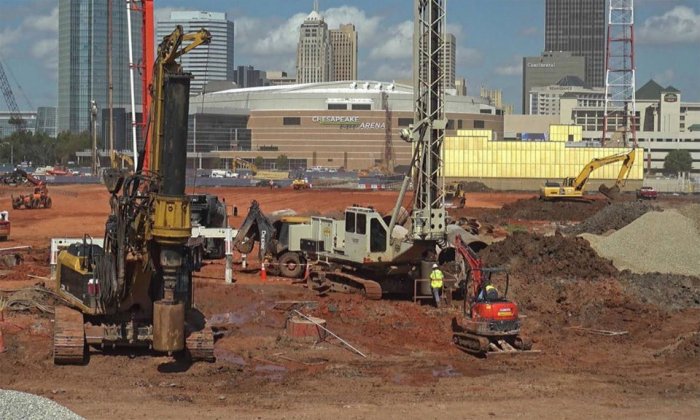7 Real Estate Trends You Need to Watch in 2025: Buckle up, buttercup, because the real estate rollercoaster of 2025 is about to whip you around faster than a squirrel on a sugar rush! From eco-conscious castles to AI-powered appraisals, the future of buying, selling, and investing in property is less “house hunting” and more “future forecasting.” Get ready to navigate the wild world of sustainable building, tech-infused transactions, and shifting demographics—all while dodging the occasional economic earthquake.
This isn’t your grandma’s real estate market (unless your grandma’s a tech-savvy, eco-warrior investor, in which case, hats off to her!).
This deep dive into seven key trends will arm you with the knowledge to make savvy decisions in the ever-evolving landscape of real estate. We’ll explore the rise of sustainable practices, the impact of technology on transactions, the shifting preferences of different generations, and the influence of remote work on where people choose to live. We’ll also delve into the exciting world of smart homes, analyze evolving investment strategies, and examine the economic forces shaping the market.
By the end, you’ll be able to predict the future of real estate with the accuracy of a seasoned crystal ball gazer (well, almost!).
The Rise of Sustainable Real Estate
In 2025, the real estate landscape is undergoing a profound transformation, driven by a growing awareness of environmental responsibility and the urgent need for sustainable practices. The demand for eco-friendly buildings isn’t just a trend; it’s a fundamental shift in how we design, construct, and inhabit our spaces. This movement is fueled by a confluence of factors, from increasing consumer demand for greener options to stringent government regulations and compelling financial incentives.The increasing demand for eco-friendly building materials and energy-efficient designs reflects a broader societal shift towards environmental consciousness.
Consumers are actively seeking homes and commercial spaces that minimize their carbon footprint, aligning their lifestyle choices with their values. This translates into a robust market for sustainable real estate, driving innovation and pushing the boundaries of green building technology.
Innovative Sustainable Real Estate Practices
Several innovative practices are shaping the future of sustainable real estate. For example, the integration of renewable energy sources, such as solar panels and wind turbines, is becoming increasingly common. Buildings are being designed to maximize natural light and ventilation, reducing reliance on artificial lighting and air conditioning. The use of smart home technology allows for optimized energy consumption, further minimizing environmental impact.
Furthermore, the incorporation of green roofs and walls not only improves insulation but also contributes to biodiversity and stormwater management. The use of recycled and reclaimed materials in construction is also gaining traction, diverting waste from landfills and reducing the demand for virgin resources. Prefabricated modular construction methods are gaining popularity as they reduce waste, construction time and transportation needs.
Financial Incentives and Government Regulations
Governments worldwide are implementing policies to incentivize sustainable development and regulate environmentally harmful practices. Tax credits, grants, and subsidies are offered to developers and homeowners who adopt sustainable building practices. These incentives significantly reduce the upfront cost of green building, making it more accessible and economically viable. Stringent building codes and regulations are also being implemented, setting minimum standards for energy efficiency, water conservation, and the use of sustainable materials.
These regulations ensure that new construction adheres to environmental standards, contributing to a broader reduction in carbon emissions and resource consumption.
Cost-Effectiveness of Traditional vs. Sustainable Building Methods
The initial investment in sustainable building methods may seem higher, but the long-term benefits often outweigh the additional upfront costs. While traditional methods prioritize short-term cost savings, sustainable approaches focus on long-term value and reduced operational expenses.
| Method | Initial Cost | Long-Term Cost | Environmental Impact |
|---|---|---|---|
| Traditional Construction | Lower | Higher (energy, maintenance) | Higher (carbon emissions, resource depletion) |
| Sustainable Construction (Passive House, LEED Certified) | Higher | Lower (energy, maintenance) | Lower (reduced carbon footprint, sustainable materials) |
Note: The specific cost differences will vary depending on location, building design, and the specific sustainable technologies employed. However, the trend shows that while initial costs are higher for sustainable methods, long-term savings in energy and maintenance often make them a more financially sound investment. For instance, a LEED-certified building in California might see a 20-30% reduction in energy costs compared to a traditionally built equivalent, quickly offsetting the initial premium.
Passive House certified homes in Germany consistently demonstrate significant energy savings over time, demonstrating the long-term economic viability of sustainable construction practices.
The Impact of Technology on Real Estate Transactions
The real estate industry, traditionally steeped in paperwork and in-person interactions, is undergoing a dramatic transformation fueled by technological advancements. From virtual tours that transcend geographical boundaries to blockchain’s promise of streamlined transactions, technology is reshaping how properties are bought, sold, and managed. This evolution is not just about efficiency; it’s about creating a more transparent, secure, and accessible real estate market for everyone.The integration of technology is revolutionizing every facet of real estate, impacting everything from initial property searches to final closing documents.
This dynamic shift presents both exciting opportunities and considerable challenges for all stakeholders, demanding adaptability and a willingness to embrace innovation.
Virtual and Augmented Reality in Property Viewings and Marketing
Virtual and augmented reality (VR/AR) technologies are rapidly changing how potential buyers experience properties. VR offers immersive 360° tours, allowing prospective buyers to explore properties remotely, saving time and travel expenses. Imagine stepping into a sun-drenched Mediterranean villa from the comfort of your own home, experiencing the layout, and even interacting with virtual furniture – all without leaving your chair.
AR, on the other hand, overlays digital information onto the real world, enhancing the in-person viewing experience. For example, an AR app could display a property’s historical details or projected renovations directly onto the walls during a physical viewing. This blend of virtual and augmented reality is significantly expanding the reach of real estate marketing, enabling developers to showcase their projects to a global audience and buyers to make more informed decisions.
Blockchain Technology in Property Ownership and Transactions
Blockchain technology, the backbone of cryptocurrencies, is poised to revolutionize property ownership and transactions. Its decentralized, transparent, and secure nature offers a compelling alternative to traditional title registration systems, which can be slow, cumbersome, and prone to errors. A blockchain-based system would record property ownership and transactions immutably, creating a single, verifiable source of truth accessible to all parties involved.
This would streamline the process, reduce fraud, and enhance transparency, making the entire process more efficient and secure. While still in its early stages of adoption in the real estate sector, successful pilot projects and growing regulatory support indicate a promising future for blockchain in this field. One example is the use of smart contracts, which automatically execute pre-defined agreements once certain conditions are met, further automating and simplifying the transactional process.
Innovative Real Estate Tech Platforms and Their Functionalities
A plethora of innovative real estate tech platforms are emerging, offering a wide range of functionalities to streamline various aspects of the industry. These platforms often integrate multiple technologies, offering a comprehensive suite of tools for buyers, sellers, agents, and developers. For instance, some platforms offer advanced property search tools with sophisticated filtering options, AI-powered property valuation estimates, and secure digital document management systems.
Other platforms facilitate online transactions, providing secure payment gateways and digital signing capabilities. These platforms are not only enhancing efficiency but also fostering greater transparency and collaboration among stakeholders. One notable example is the rise of PropTech companies specializing in data analytics, using vast datasets to provide valuable market insights and predict future trends.
AI-Powered Property Valuation Tools
Artificial intelligence (AI) is increasingly used to develop property valuation tools. These tools leverage machine learning algorithms to analyze vast amounts of data, including property characteristics, market trends, and comparable sales, to generate accurate property valuations. While these AI-powered tools can significantly speed up the valuation process and reduce human error, they also present challenges. The accuracy of AI valuations depends heavily on the quality and completeness of the data used to train the algorithms.
Bias in the data can lead to inaccurate valuations, particularly in areas with historically limited data or demographic disparities. Therefore, human oversight and validation remain crucial in ensuring the fairness and accuracy of AI-driven property valuations. Despite these challenges, the potential for AI to enhance the efficiency and accuracy of property valuations is undeniable, promising a more streamlined and reliable appraisal process in the future.
Shifting Demographics and Housing Preferences
The real estate landscape of 2025 is being dramatically reshaped by evolving demographics and the diverse housing preferences they bring. Understanding these shifts is crucial for investors, developers, and anyone navigating the property market. The interplay between generational needs, technological advancements, and economic factors is creating a dynamic and exciting future for housing.The next decade will witness a significant power shift in the housing market, driven primarily by the changing sizes and priorities of different generational cohorts.
Millennials, Gen Z, and Baby Boomers, each with unique needs and preferences, will continue to redefine what constitutes desirable housing. These preferences, combined with factors like urban sprawl and climate concerns, are creating new opportunities and challenges for the real estate industry.
Millennial, Gen Z, and Baby Boomer Housing Needs
Millennials (born 1981-1996), now firmly established in their careers and many starting families, are seeking larger spaces than their earlier rental preferences suggested. They value proximity to urban amenities, walkability, and access to public transportation. However, the rising cost of living in many urban centers is pushing some towards suburban areas with better value for their money. Gen Z (born 1997-2012), entering the workforce and seeking their first homes, often prioritize affordability and technology integration.
Smart home features, high-speed internet access, and sustainable design elements are increasingly important to this tech-savvy generation. Baby Boomers (born 1946-1964), many of whom are downsizing or entering retirement, favor low-maintenance properties, often in age-restricted communities or areas with access to healthcare and recreational facilities. Their priorities often include accessibility, security, and proximity to family and friends.
Visual Representation of Diverse Housing Preferences, 7 Real Estate Trends You Need to Watch in 2025
Imagine a three-panel infographic. The first panel, representing Millennials, shows a vibrant, modern townhouse in a walkable urban neighborhood, complete with bike racks and a shared community garden. The image suggests a balance between urban convenience and community connection. The second panel, showcasing Gen Z, depicts a smaller, eco-friendly apartment building with solar panels and smart technology features prominently displayed.
The building’s design is clean, minimalist, and technologically advanced, emphasizing sustainability and convenience. The third panel, dedicated to Baby Boomers, portrays a comfortable, single-story ranch home in a quiet suburban neighborhood with a well-maintained garden and easy access to walking trails. The home’s design emphasizes accessibility and ease of maintenance, reflecting the needs and preferences of this generation.
The overall infographic uses a consistent color palette to maintain visual harmony, but each panel employs unique colors and imagery to highlight the distinct preferences of each generation.
The Influence of Remote Work on Real Estate Markets

The rise of remote work has fundamentally reshaped the real estate landscape, creating ripples across urban, suburban, and rural communities. No longer tethered to a city center office, professionals are re-evaluating their living situations, driving significant shifts in demand and impacting property values in unexpected ways. This evolution presents both challenges and opportunities for investors, developers, and homeowners alike.The flexibility offered by remote work has spurred a significant migration from urban centers to suburban and rural areas.
This exodus is fueled by the desire for more space, a lower cost of living, and a better quality of life. This shift is not merely a trend; it’s a seismic change altering the very fabric of how we live and work.
The Impact of Remote Work on Suburban and Rural Real Estate Markets
The increased demand for housing outside of major cities has led to a surge in property values and a tightening of inventory in many suburban and rural areas. Towns once considered sleepy bedroom communities are now experiencing rapid growth, attracting new residents and businesses. This influx of people is creating new challenges, including increased strain on infrastructure and local services.
However, it also presents economic opportunities for these communities, fostering new development and revitalizing existing infrastructure. For example, the town of Bozeman, Montana, saw a dramatic increase in property values and population growth due to an influx of remote workers seeking a more outdoor-oriented lifestyle. Similarly, smaller towns in states like Colorado and Vermont experienced similar booms.
Demand for Larger Homes with Home Offices
The need for a dedicated workspace at home has driven a significant increase in demand for larger homes with home offices or spaces easily adaptable for professional use. This shift is evident in the types of properties that are most in-demand. Homes with extra bedrooms, finished basements, or even detached structures are highly sought after. This trend is particularly noticeable in the higher-end market, where larger properties are often equipped with dedicated home offices, state-of-the-art technology, and amenities designed to enhance productivity and work-life balance.
For example, the market for homes with dedicated home offices has seen a double-digit percentage increase in sales in many suburban areas compared to pre-pandemic levels.
Successful Real Estate Strategies Targeting Remote Workers
Real estate professionals are adapting their strategies to cater to the needs of remote workers. This includes focusing on marketing properties that highlight features attractive to this demographic, such as high-speed internet access, proximity to outdoor recreation, and access to quality schools. Many real estate agents are also leveraging virtual tours and online marketing tools to reach a wider audience of potential buyers.
Additionally, some developers are constructing new communities specifically designed to appeal to remote workers, incorporating amenities such as co-working spaces, fitness centers, and walking trails. A successful example is seen in the development of “work-from-home” communities in the outskirts of major cities, providing a balance of suburban tranquility and easy access to urban amenities.
Urban vs. Suburban Living for Remote Workers: A Comparison
The choice between urban and suburban living for remote workers often depends on individual priorities and preferences. However, a clear comparison highlights the advantages and disadvantages of each:
Weighing the pros and cons, the ideal location for a remote worker depends on their personal priorities and lifestyle preferences. Some thrive in the energy and cultural richness of urban centers, while others prioritize space, tranquility, and a slower pace of life in suburban or rural settings.
- Urban Living Advantages: Proximity to cultural attractions, restaurants, and entertainment; easy access to public transportation; a vibrant social scene.
- Urban Living Disadvantages: Higher cost of living, smaller living spaces, less privacy, higher noise levels.
- Suburban Living Advantages: More spacious homes, larger yards, quieter environments, access to better schools, lower cost of living (in many areas).
- Suburban Living Disadvantages: Longer commutes (even if only occasional), less access to public transportation, potentially less vibrant social scene.
The Growing Importance of Smart Homes
In 2025, the smart home is no longer a futuristic fantasy; it’s a rapidly evolving reality reshaping the real estate landscape. The seamless integration of technology into our living spaces is transforming how we interact with our homes, impacting not only convenience but also property value and the overall buyer appeal. This trend reflects a growing desire for enhanced comfort, security, and energy efficiency, driving significant changes in the construction and renovation sectors.Smart home technology in 2025 offers a plethora of features designed to simplify daily life and enhance security.
Imagine a home that anticipates your needs, adjusting lighting and temperature based on your schedule and preferences. This level of automation isn’t just about convenience; it’s about creating a personalized living experience tailored to individual lifestyles and priorities. Features such as voice-activated assistants, automated lighting systems, smart thermostats, and security systems are becoming increasingly commonplace, offering homeowners unprecedented control over their environment.
The ability to remotely monitor and control various aspects of the home, from appliances to security cameras, adds another layer of convenience and peace of mind.
Smart Home Integration and Property Value
The integration of smart home technology significantly enhances a property’s value and appeal to potential buyers. In a competitive market, properties equipped with advanced smart home features stand out, attracting a wider pool of interested buyers and potentially commanding higher sale prices. Buyers are increasingly willing to pay a premium for the convenience, security, and energy efficiency offered by smart home systems.
Real estate agents are already noticing this trend, with many advising clients to incorporate smart home technology to maximize the return on their investment. For example, a home equipped with a sophisticated smart security system might sell faster and for a higher price than a comparable property without such features. The increased energy efficiency resulting from smart thermostats and lighting also translates into lower utility bills, a significant selling point for many buyers.
Examples of Popular Smart Home Devices and Systems
Several popular smart home devices and systems are leading this technological revolution. Amazon’s Alexa and Google Home are ubiquitous examples of voice-activated assistants controlling lighting, entertainment systems, and other connected devices. Nest thermostats offer programmable temperature control, learning user preferences to optimize energy consumption. Smart locks, such as those offered by August and Schlage, allow for keyless entry and remote access control.
Ring security cameras provide real-time monitoring and alerts, enhancing home security. These are just a few examples of the many smart home devices available, offering a wide range of functionalities to suit various needs and budgets. The interconnectivity of these systems is also noteworthy, allowing homeowners to create a unified and integrated smart home experience. For instance, a user might program their smart lighting system to automatically turn on when the security system detects motion, providing an additional layer of deterrence.
Security and Privacy Concerns of Smart Home Technology
While the benefits of smart home technology are numerous, it is crucial to address potential security and privacy concerns. The increasing number of connected devices in a home creates potential vulnerabilities to cyberattacks. Hackers could potentially gain unauthorized access to sensitive data or control home systems remotely. Data privacy is another critical concern, as smart home devices often collect and store personal information.
It is essential for homeowners to choose reputable brands and implement robust security measures to mitigate these risks. This includes regularly updating software, using strong passwords, and being mindful of the data collected by various devices. The responsible use of smart home technology, coupled with awareness of potential risks, is vital to ensuring a secure and privacy-respecting smart home environment.
Consider the example of a smart refrigerator that tracks food consumption; while convenient, it also raises questions about the collection and use of personal data.
The Evolution of Real Estate Investment Strategies
The landscape of real estate investment is undergoing a dramatic transformation, driven by technological advancements, shifting economic conditions, and evolving investor preferences. No longer is the traditional model of buying a single-family home for rental income the sole path to success. Instead, a diverse range of opportunities is emerging, catering to a broader spectrum of risk tolerances and financial goals.
This evolution presents both challenges and exciting possibilities for those seeking to participate in this dynamic market.The rise of sophisticated investment vehicles and the increasing accessibility of market information have democratized real estate investment, allowing individuals with diverse financial backgrounds to participate in previously inaccessible opportunities. This expansion is fueled by a desire for diversification, higher potential returns, and the pursuit of passive income streams.
Understanding these new trends and strategies is crucial for navigating the complexities of the modern real estate market and maximizing investment potential.
Alternative Investment Vehicles: The Rise of REITs and Beyond
Real Estate Investment Trusts (REITs) have gained significant traction as an accessible and diversified investment vehicle. REITs pool capital from multiple investors to acquire and manage income-producing real estate, offering investors a share in the profits without the direct management responsibilities of owning individual properties. This fractional ownership approach lowers the barrier to entry, making real estate investment accessible to a wider audience.
Beyond REITs, other alternative investment vehicles are gaining popularity, including private equity funds focused on real estate, crowdfunding platforms connecting investors with developers, and specialized investment vehicles targeting specific real estate sectors, such as data centers or self-storage facilities. These alternatives offer varying levels of risk and return, allowing investors to tailor their portfolios to their specific risk appetites.
Comparing Traditional and Modern Investment Strategies
Traditional real estate investment strategies, often involving the direct purchase and management of properties, require significant capital, time commitment, and expertise in property management and maintenance. This approach, while potentially offering higher returns, carries substantial risk, including the potential for vacancy, unexpected repairs, and market fluctuations. Modern strategies, on the other hand, offer greater diversification and reduced management burdens.
REITs, for example, provide instant diversification across multiple properties and geographic locations, mitigating the risk associated with a single property investment. Crowdfunding platforms also offer diversification by spreading investments across numerous projects. Furthermore, technology is streamlining the investment process, making it more efficient and transparent.
Real Estate Investment Options: A Comparative Overview
| Investment Type | Risk Level | Potential Return | Liquidity |
|---|---|---|---|
| Direct Property Ownership | High | High (potentially) | Low |
| REITs | Medium | Medium | High |
| Real Estate Crowdfunding | Medium to High | Medium to High (potentially) | Low to Medium |
| Private Equity Real Estate Funds | High | High (potentially) | Low |
Economic Factors Shaping the Real Estate Landscape
The real estate market, a cornerstone of any economy, is profoundly influenced by a complex interplay of economic forces. Understanding these dynamics is crucial for investors, developers, and homeowners alike, as they dictate market trends, price fluctuations, and overall investment viability. 2025 presents a unique landscape, shaped by lingering effects of past events and the emergence of new economic realities.
Navigating this terrain requires a keen awareness of the major economic factors at play.The health of the real estate sector is intrinsically linked to broader economic indicators. Inflation, interest rates, and economic growth act as powerful levers, shaping market behavior in significant ways. Government policies, designed to stimulate or restrain economic activity, also exert a considerable influence, creating both opportunities and challenges for those involved in the real estate market.
Forecasting future market performance necessitates considering various economic scenarios, ranging from robust growth to periods of contraction.
Inflation’s Impact on Real Estate Prices
Inflation, the persistent increase in the general price level of goods and services, directly impacts real estate prices. High inflation erodes the purchasing power of money, making properties more expensive. This leads to increased demand as buyers rush to secure assets before prices rise further. Conversely, low inflation can create a more stable market, though potentially slowing price appreciation.
For example, the high inflation experienced in many countries during 2022-2023 resulted in significant increases in real estate prices, particularly in areas with already strong demand. This effect was amplified by increased construction costs, further contributing to rising property values.
Interest Rates and Mortgage Affordability
Interest rates play a pivotal role in determining mortgage affordability. Higher interest rates increase borrowing costs, making mortgages more expensive and reducing the number of potential buyers. This can lead to a slowdown in the market, decreased demand, and potentially lower prices. Conversely, lower interest rates make mortgages more accessible, stimulating demand and potentially driving up prices.
The Federal Reserve’s interest rate hikes in 2022 and 2023, for instance, significantly impacted the US housing market, leading to a decline in sales and a slowdown in price growth. This illustrates the direct relationship between interest rates and real estate market activity.
Economic Growth and Real Estate Investment
Strong economic growth generally fuels real estate investment. A thriving economy leads to increased job creation, higher incomes, and greater consumer confidence, all of which boost demand for housing and commercial properties. Conversely, economic downturns can severely impact the real estate sector, leading to decreased investment, lower property values, and increased foreclosures. The 2008 financial crisis serves as a stark reminder of the devastating effects of a recession on the real estate market.
The subsequent recovery, however, highlighted the resilience of the sector and its capacity for rebound.
Economic Policies and Real Estate Development
Government economic policies significantly influence real estate development. Tax incentives, zoning regulations, and infrastructure spending can either stimulate or hinder development activity. For example, tax breaks for developers of affordable housing can increase the supply of affordable units, while strict zoning regulations can limit development and drive up prices. Similarly, government investment in infrastructure, such as transportation networks, can increase the value of properties in surrounding areas.
Conversely, policies aimed at curbing speculation, such as increased capital gains taxes on property sales, can dampen investment and development activity.
Economic Scenarios and Market Performance
The following bullet points illustrate how different economic scenarios could impact real estate market performance in 2025:
- Scenario 1: Strong Economic Growth and Low Inflation: This scenario would likely lead to increased demand, rising prices, and robust investment activity in the real estate sector. Similar to the pre-pandemic period in many markets.
- Scenario 2: Moderate Economic Growth and Moderate Inflation: This scenario would likely result in a relatively stable market, with moderate price appreciation and steady investment activity. A potential “soft landing” scenario.
- Scenario 3: Slow Economic Growth and High Inflation: This scenario could lead to decreased demand, stagnating or declining prices, and reduced investment activity. Similar to market conditions experienced in some regions in the latter half of 2023.
- Scenario 4: Recession: A recession would likely cause a significant downturn in the real estate market, characterized by sharp price declines, reduced investment, and increased foreclosures. A scenario with parallels to the 2008 financial crisis, although the specifics would vary depending on the nature and severity of the recession.
Wrap-Up
So, there you have it: a whirlwind tour of the seven real estate trends set to dominate 2025. From the green revolution in building materials to the rise of the digital property market and the impact of shifting demographics and remote work, the future of real estate is dynamic, innovative, and brimming with opportunities. While navigating this exciting landscape, remember to stay informed, adapt to change, and embrace the technological advancements that are reshaping the industry.
Don’t just watch these trends – ride the wave and maybe, just maybe, you’ll strike real estate gold (or at least a really nice, energy-efficient home!).
Key Questions Answered: 7 Real Estate Trends You Need To Watch In 2025
What are the biggest risks associated with investing in sustainable real estate?
Higher upfront costs and potential for unforeseen technological advancements rendering certain sustainable features obsolete are key risks. However, long-term cost savings and increased property value often outweigh these concerns.
How can blockchain technology improve real estate security?
Blockchain enhances security by providing a transparent, tamper-proof record of property ownership, minimizing fraud and streamlining the transaction process.
Will AI-powered property valuation tools replace human appraisers entirely?
Unlikely. While AI can assist with valuations, human expertise is still crucial for considering nuanced factors and avoiding potential biases in data.
What are the downsides of smart home technology?
Security vulnerabilities and privacy concerns are major downsides. Data breaches and potential hacking are risks that need careful mitigation.
What’s the best way for a beginner to invest in real estate in 2025?
Start with education! Research different investment options, understand your risk tolerance, and consider consulting with a financial advisor before making any significant investments.




